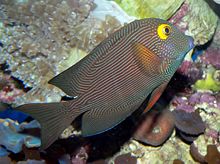Ctenochaetus
| Ctenochaetus | |
|---|---|
 | |
| Ctenochaetus strigosus | |
| Scientific classification | |
| Domain: | Eukaryota |
| Kingdom: | Animalia |
| Phylum: | Chordata |
| Class: | Actinopterygii |
| Order: | Acanthuriformes |
| Family: | Acanthuridae |
| Tribe: | Acanthurini |
| Genus: | Ctenochaetus T. N. Gill, 1884 |
| Type species | |
| Acanthurus strigosus E. T. Bennett 1828[1] | |
| Species | |
| See text | |
| Synonyms[1] | |
| |
Ctenochaetus, or bristletooth tangs, is a genus of marine ray-finned fish belonging to the family Acanthuridae, which includes the surgeonfishes, unicornfishes and tangs. These fishes are found in the Indo-Pacific region. They have many, small flexible teeth and some species have the common name bristletooth.
Taxonomy[edit]
Ctenochaetus was first proposed as a genus in 1884 by the American biologist Theodore Gill with Acanthurus strigosus as its type species.[1] A. strigosus had originally been described in 1828 by Edward Turner Bennett from the Sandwich Islands.[2]
It has been proposed that this genus and Acanthurus should be merged as otherwise Acanthurus is paraphyletic, A. nubilis and A. pyroferus were found to form a clade with Ctenochaetus.[3] The 5th edition of Fishes of the World recognises these two genera as valid and classifies them as the two genera in the tribe Acanthurini of the subfamily Acanthurinae within the family Acanthuridae.[4]
Etymology[edit]
Ctenochaetus Is a compound of cteno, meaning “bristle”, and chaetus, meaning “comb”. Gill did not explain what this alluded to but it is almost certain to allude to the bristle or comb like teeth if these fishes.[5]
Species[edit]
Ctenochaetus currently has nine recognised species classified within it:[6]
- Ctenochaetus binotatus J. E. Randall, 1955 (Twospot surgeonfish)
- Ctenochaetus cyanocheilus J. E. Randall & Clements, 2001 (Short-tail bristle-tooth)
- Ctenochaetus flavicauda Fowler, 1938 (Whitetail bristletooth)
- Ctenochaetus hawaiiensis J. E. Randall, 1955 (Chevron tang)
- Ctenochaetus marginatus (Valenciennes, 1835) (Striped-fin surgeonfish)
- Ctenochaetus striatus (Quoy & Gaimard, 1825) (Striated surgeonfish)
- Ctenochaetus strigosus (E. T. Bennett, 1828) (Kole Tang)
- Ctenochaetus tominiensis J. E. Randall, 1955 (Tomini surgeonfish)
- Ctenochaetus truncatus J. E. Randall & Clements, 2001 (Indian gold-ring bristle-tooth)
Characteristics[edit]
Ctenochaetus surgeonfishes are closely related to the surgeonfishes in the genus Acanthurus and are very similar to them. They have a different jaw structure from the Acanthurus surgeonfishes having numerous brush or bristle like flexible teeth. Their dorsal fin is supported by 8 spines and between 24 and 31 soft rays while their anal fins are supported by 3 spines and between 22 and 28 soft rays.[7][5] These fish vary in length from a maximum published standard length of 15 cm (5.9 in) in C. strigosus to a maximum published total length of 27 cm (11 in) in C. marginatus.[6]
Distribution[edit]
Ctenochaetus surgeonfishes have a wide Indo-Pacific distribution. They are found from the eastern coast of Africa, includiong the Red Sea eastwards through the tropical Indian Ocean into the Pacific Ocean as far east as Hawaii.[7][6]
References[edit]
- ^ a b c Eschmeyer, William N.; Fricke, Ron & van der Laan, Richard (eds.). "Genera in the family Acanthuridae". Catalog of Fishes. California Academy of Sciences. Retrieved 2 October 2023.
- ^ Bennett, E. T. (1828). "Observations on the fishes contained in the collection of the Zoological Society. On some fishes from the Sandwich Islands". Zoological Journal, London. 4 (13): 31–42.
- ^ Laurie Sorenson; Francesco Santini; Giorgio Carnevale; Michael E. Alfaro (2013). "A multi-locus timetree of surgeonfishes (Acanthuridae, Percomorpha), with revised family taxonomy". Molecular Phylogenetics and Evolution. 68 (1): 150–160. doi:10.1016/j.ympev.2013.03.014. ISSN 1055-7903.
- ^ J. S. Nelson; T. C. Grande; M. V. H. Wilson (2016). Fishes of the World (5th ed.). Wiley. pp. 497–502. ISBN 978-1-118-34233-6.
- ^ a b Christopher Scharpf & Kenneth J. Lazara, eds. (12 January 2021). "Order ACANTHURIFORMES (part 2): Families EPHIPPIDAE, LEIOGNATHIDAE, SCATOPHAGIDAE, ANTIGONIIDAE, SIGANIDAE, CAPROIDAE, LUVARIDAE, ZANCLIDAE and ACANTHURIDAE". The ETYFish Project Fish Name Etymology Database. Christopher Scharpf and Kenneth J. Lazara. Retrieved 4 October 2023.
- ^ a b c Froese, Rainer and Pauly, Daniel, eds. (2023). Species of Ctenochaetus in FishBase. June 2023 version.
- ^ a b John E. Randall (2022). "Family Acanthuridae". In Phillip C Heemstra; Elaine Heemstra; David A Ebert; Wouter Holleman; John E Randall (eds.). Coastal Fishes of the Western Indian Ocean (PDF). Vol. 5. South African Institute for Aquatic Biodiversity. pp. 219–244. ISBN 978-1-990951-32-9. Archived (PDF) from the original on 2023-06-12. Retrieved 2023-07-17.


 French
French Deutsch
Deutsch